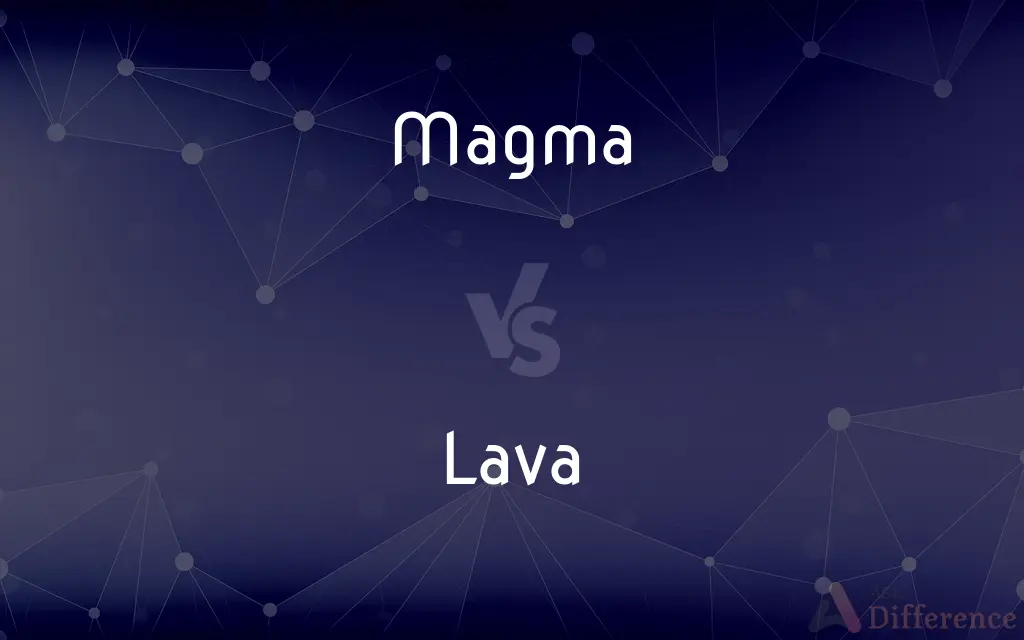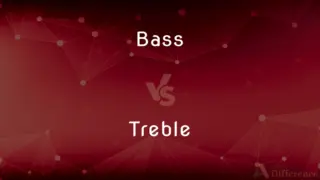Magma vs. Lava — What's the Difference?
By Tayyaba Rehman — Updated on September 23, 2023
Magma is molten rock beneath the Earth's surface; lava is when magma reaches the surface. Magma stays hidden; lava is what we see erupt.

Difference Between Magma and Lava
Table of Contents
ADVERTISEMENT
Key Differences
Magma, in its essence, is molten rock located beneath the Earth's crust. This substance consists of melted minerals, dissolved gases, and even solid crystals, which together create a thick, fluid mass. The existence of magma, primarily in the mantle, is a testament to the intense heat and pressure that characterize our planet's inner regions. Without this internal heat, magma wouldn't exist.
Lava, on the other hand, is the name given to magma once it reaches and flows on the Earth's surface. When a volcano erupts, the molten rock that gushes or seeps out is termed lava. As it cools and solidifies, lava forms various types of volcanic landforms, including plateaus, cones, and mountains. The sight of red-hot lava flowing from a volcano is both mesmerizing and testament to Earth's geothermal power.
The transition from magma to lava occurs during volcanic eruptions. Magma pools in chambers under volcanoes, and certain triggers like tectonic movements or pressure changes can cause this magma to ascend. Once magma breaches the surface, it sheds its identity and becomes lava, beginning its journey of reshaping landscapes.
Interestingly, while both magma and lava are molten rock, their interaction with the environment differs. Magma can cause earthquakes or uplift the ground as it accumulates and moves. Lava, conversely, interacts with air, water, or land, leading to rapid cooling, solidification, and occasionally explosive reactions, especially if it encounters water.
Comparison Chart
Location
Beneath the Earth's surface
On the Earth's surface
ADVERTISEMENT
Interaction
With surrounding rocks and chambers
With air, water, and land
Temperature
Generally hotter
Cools rapidly upon reaching the surface
Physical State
Molten rock, may contain solid crystals and dissolved gases
Molten rock, starts solidifying upon exposure to cool air
Result of
Earth's internal heat and pressure
Eruption of magma from volcanoes
Compare with Definitions
Magma
A hot fluid within the Earth responsible for volcanic activity.
Magma's movement can cause minor tremors in the region.
Lava
Solidifying rock material originating from volcanic eruptions.
The lava had cooled, forming a black, rocky crust.
Magma
A mixture of liquid rock, crystals, and gases beneath the Earth.
The chamber was filled with magma, waiting to erupt.
Lava
The external manifestation of volcanic activity.
Tourists were fascinated by the glowing lava flow.
Magma
The precursor to lava when still underground.
If the magma rises, it can lead to an eruption.
Lava
A hot substance that emerges from volcanoes and cools to form rock.
The island was formed by layers of lava over time.
Magma
Magma (from Ancient Greek μάγμα (mágma) 'thick unguent') is the molten or semi-molten natural material from which all igneous rocks are formed. Magma is found beneath the surface of the Earth, and evidence of magmatism has also been discovered on other terrestrial planets and some natural satellites.
Lava
Molten rock that has erupted onto Earth's surface.
The volcano spewed lava, covering the nearby plains.
Magma
(Geology) The molten rock material under the earth's crust, from which igneous rock is formed by cooling.
Lava
Lava is molten rock (magma) that has been expelled from the interior of a terrestrial planet (such as Earth) or a moon. Magma is generated by the internal heat of the planet or moon and it is erupted as lava at volcanoes or through fractures in the crust, usually at temperatures from 800 to 1,200 °C (1,470 to 2,190 °F).
Magma
(Pharmacology) A suspension of particles in a liquid, such as milk of magnesia.
Lava
Molten rock that reaches the earth's surface through a volcano or fissure.
Magma
A mixture of finely divided solids with enough liquid to produce a pasty mass.
Lava
The rock formed by the cooling and solidifying of molten rock.
Magma
(Archaic) The residue of fruits after the juice has been expressed; pomace.
Lava
The molten rock ejected by a volcano from its crater or fissured sides.
Magma
(geology) The molten matter within the earth, the source of the material of lava flows, dikes of eruptive rocks, etc.
Lava
Magma.
Magma
(mathematics) A basic algebraic structure consisting of a set equipped with a single binary operation.
Lava
A shade of red, named after the volcanic lava.
Magma
Any soft doughy mass.
Lava
The melted rock ejected by a volcano from its top or fissured sides. It flows out in streams sometimes miles in length. It also issues from fissures in the earth's surface, and forms beds covering many square miles, as in the Northwestern United States.
Magma
The residuum after expressing the juice from fruits.
Lava
Rock that in its molten form (as magma) issues from volcanos; lava is what magma is called when it reaches the surface
Magma
Any crude mixture of mineral or organic matters in the state of a thin paste.
Lava
Magma that has reached the outer environment.
Lava flows can reshape landscapes dramatically.
Magma
A thick residuum obtained from certain substances after the fluid parts are expressed from them; the grounds which remain after treating a substance with any menstruum, as water or alcohol.
Magma
The molten matter within the earth, the source of the material of lava flows, dikes of eruptive rocks, etc.
Magma
The amorphous or homogenous matrix or ground mass, as distinguished from well-defined crystals; as, the magma of porphyry.
Magma
Molten rock in the earth's crust
Magma
Molten rock material below Earth's crust.
Scientists study magma to predict volcanic eruptions.
Magma
The source of igneous rock formation beneath the surface.
Granite forms from the slow cooling of magma.
Common Curiosities
What happens when magma reaches the Earth's surface?
When magma breaches the surface, it becomes lava.
Can we see magma?
Typically, no, since it's underground. However, lava is magma that we can observe.
What's the difference between a magma chamber and a lava flow?
A magma chamber is an underground pool of magma, while a lava flow is lava moving on the surface.
Where is magma located?
Magma is located beneath the Earth's crust, primarily in the mantle.
Is lava always red-hot and glowing?
Initially, yes, but it cools and can become black and solid.
Does magma have a consistent composition?
No, magma's composition can vary based on the rocks that melted to form it.
Can lava exist beneath the Earth's surface?
No, once it's beneath the surface, it's termed magma.
How does lava create islands?
Lava from underwater eruptions can accumulate over time, forming islands.
Why does magma form?
Magma forms due to the Earth's internal heat and pressure melting rocks.
Are lava and magma the same temperature?
No, magma is generally hotter, but lava cools rapidly upon exposure to the atmosphere.
Why is studying magma important?
Understanding magma can help predict volcanic eruptions and learn about Earth's interior.
How fast can lava flow?
It varies, from slow crawls to 60 mph in some eruptions.
Can lava's temperature vary?
Yes, depending on its composition and the nature of the eruption.
Is magma only found under volcanoes?
No, while concentrated there, magma exists in various parts of the Earth's mantle.
Share Your Discovery

Previous Comparison
Bullet vs. Pellet
Next Comparison
Bass vs. TrebleAuthor Spotlight
Written by
Tayyaba RehmanTayyaba Rehman is a distinguished writer, currently serving as a primary contributor to askdifference.com. As a researcher in semantics and etymology, Tayyaba's passion for the complexity of languages and their distinctions has found a perfect home on the platform. Tayyaba delves into the intricacies of language, distinguishing between commonly confused words and phrases, thereby providing clarity for readers worldwide.
















































